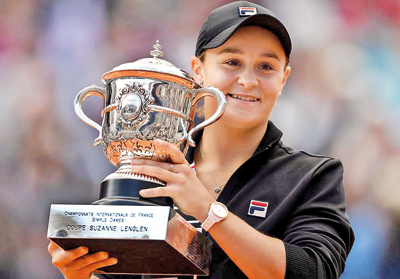Ashleigh Barty is Women’s World No.1

Ashleigh Barty switched from cricket to become Australia's most celebrated women's tennis player
The last decade saw a string of Women Tennis players from USA, Canada, Eastern and Western Europe, Scandinavia, Russia and the Baltic States getting into the Top 10 and aspiring for the No.1 position. Without a good candidate, we discounted Australia altogether. Here comes the surprise, Ashleigh Barty, an Australian who was just another in the ranking a year ago, has cracked the thick ice layer of top players and come through to be the No.1 player of the world. This year, to date, Barty’s performances defy gravity.
The 23-year-old Ashley Barty, standing at 5’5″, is the 27th to grab the World No.1 position of the WTA ranking in the Open-era. Barty totalled 6,540 points, a few hundred points more than Naomi Osaka. Barty’s title win last week in Birmingham on Grass courts, beating Julia Goerges of Germany, gave her those points. Australia still has a good number of Grass courts. It encourages the Net game, giving the competence to Volley. With her ability to play at Net, she is also No.7 in Doubles ranking.
Barty tried her hand at Cricket, but returned to Tennis, to earn over US$ 10 millions. Her Win-Loss record of 36-5, speaks for itself. The French Open title she won a few weeks ago, was her 1st Grand Slam title.
The older players in the Top 10 are on the wane. Along with Barty, there are many in her age group who can topple them. Stardom does not always boost performance. Naomi Osaka is struggling to cope with the success she had in the US Open last year and Australian Open this year. Maturity is a necessity to accept ‘Spotlight’ position and to perform.
Barty’s game
The Women’s field is very tough now. Apart from the challenges from known names such as Elina Svitolina and Aryna Sablenka, and returning players Petra Kvitova and Belinda Bencic, a few newcomers are emerging with strong game efficiency. They are Bianca Andreescu, Amanda Anismova, Sofia Kenin and Marketa Vondrousova. Naomi Osaka [20] and Asleigh Barty have already made their mark, winning Grand Slams.
All predict that Asleigh Barty will prevail a good while. There are no weaknesses in her game. Her ground-strokes, Net game and tactics are on the up and improving. Accommodating the long Tennis calendar could be her issue. Osaka and Andreescu already appear to play with tell-tale strain-support bandages. When young, professional Tennis is very severe.
By playing Doubles, Barty’s All-court game was sharpened. In Singles, her Net play and her 1st Serve, with placement and speed, has carried her through on many occasions. She is a strong contender for this year’s Wimbledon title, which begins tomorrow. Against very good players, Barty was able to take a lot of punishment and still win. This frightens many opponents.
‘Executioners’
In the past 20 years, Nadal and some while ago, Serena Williams, and in the past, Jimmy Connors, Pete Sampras, Martina Navratilova and Steffi Graf came under the category of ‘executioners’. On a given day, they just walked past any challenge. Boris Becker going to play Sampras in Wimbledon said, “When Sampras is playing well, he is an executioner. All I can do is, ‘pray for rain’.”
Barty, if she matures on the lines she plays now, she would be another ‘executioner’. That potential she carries, which has already turned around matches considered way beyond redemption. It happened in the semifinal of this year’s French Open against Amanda Anismova. Barty led 5-1 and Animova won that Set in a tiebreak and went on to lead 3-1 in the 2nd Set. Then on, Barty prevailed and demolished Anismova. It was the closest Barty came to losing a match in the 2019 French Open.
Grass, Money
In the history of the game, Tennis had 4 different surfaces. The European summer season has Red burnt Clay and Grass courts. After the French Open, the Grass court season begins, leading to the Wimbledon Championships. A decade ago, only the British Isles had Grass events. In the last few years, Germany, Netherlands and Turkey have developed Grass court events.
 The 2 natural surfaces, Red Clay and Grass, are very challenging to players. When it comes to Grass, the unavailability to practice poses a big issue to players. Most of the Grass courts are in exclusive clubs in England, Europe, India, Pakistan and Australia.
The 2 natural surfaces, Red Clay and Grass, are very challenging to players. When it comes to Grass, the unavailability to practice poses a big issue to players. Most of the Grass courts are in exclusive clubs in England, Europe, India, Pakistan and Australia.
In Tennis, change in surface means changing habits, disciplines and routines, to conduct tactics. These are big alterations in the high-speed game of today. In the past 3 weeks, Europe had Grass court events. For players, they are the only preparation for the Grass court Grand Slam at Wimbledon. Some Clay court players opt not to play preparatory events. They concentrate on the long hard court events to come after Wimbledon, in the USA.
Money and Silence
Wimbledon is the flagship of Tennis, with the 1st Round loser taking 39,000 pounds sterling, while the title winner will take over 2.25 million pounds. The professional bodies insist their players participate, if they have eligible ranking. The draw will have 128 entries for the Singles.
A roar in a packed Football stadium is deafening. On the Centre court of Wimbledon, with every seat occupied, the ‘silence’ that prevails is ‘frightening’. The game of Tennis demands a player to be a lonely and immaculate warrior.
George Paldano, Int. player; Accredited Coach of German Federation; National coach Davis-Cup, Federation Cup captain/coach– contact 94 77 544 8880 geodano2015 @gmail.com -


